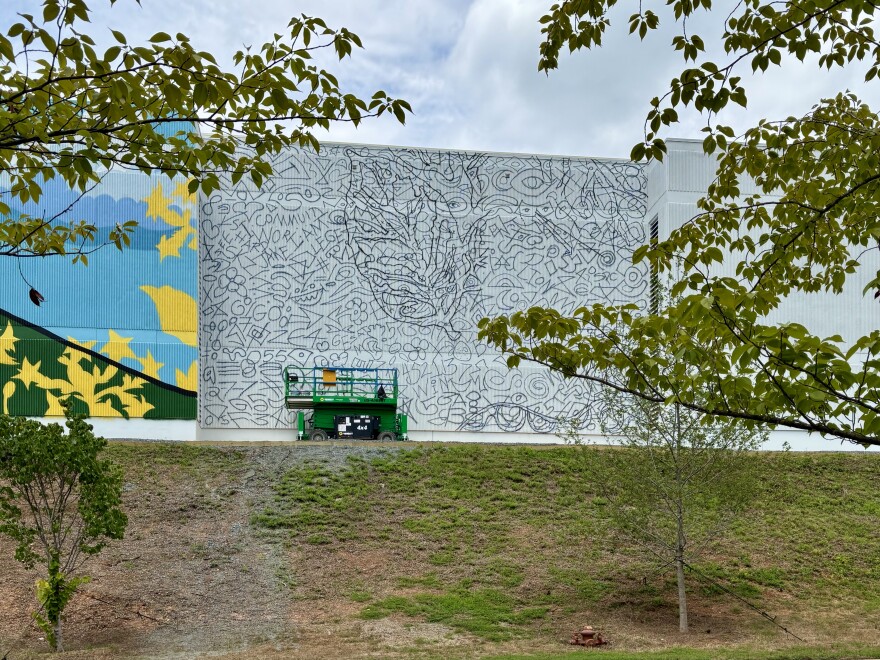On her regular drive into work, something recently caught the attention of WFDD Marketing and Events Manager Rachel Thomas.
She watched as an artist filled a massive white wall on the Reynolds Central Distribution Center in Winston-Salem with a unique design — a monochrome pattern of densely packed stars, hearts, smiley faces, and more.
For this week’s Carolina Curious, our guest reporter wanted to know — what’s the deal with all the doodles?
The designs I saw go up eventually spanned 28,000 square feet on the surface of the building, in a tightly packed grid. Was this graffiti? Art?
A few days later, I got some answers when a mural started to appear over the drawings. As it turns out, the seemingly random squiggles and symbols are part of something called a doodle grid, and it’s one way to approach the mural painting process. It solves a common problem, says artist Joey Allen.
“There's a couple different methods to scale your artwork up," he says. "But typically people will do a projector or a standard box grid method where you just run horizontal lines and vertical lines, and each box is scaled down to, you know, a certain amount of the size on your paper. However, that takes a while to get everything measured out perfectly, and the design doesn't really lay on too many of those horizontal and vertical lines.”
Allen and fellow artist Leo Rucker were commissioned by Reynolds American, formerly RJ Reynolds Tobacco Company, to paint this new piece of public art. With such a large space to fill, the two needed a surefire way to transpose their ideas from a legal-size sheet of paper to a canvas the size of a building, which is where the doodle grid comes in.
“So when you go to sketch out the design on the doodle grid. A lot of your design lays over top of some of the exact doodle grid lines to give you a more accurate sketch in scaling up the artwork.”
Allen took me over to the notes he shared with Rucker and showed me the section of the mural they were working on. I can see bright orange lines on top of the doodles, which are used as concrete reference points that create a visual roadmap for the painting.
The map might be laid, but there are still months of work ahead. And it can be grueling — as long as it isn’t storming, the men are out painting high above the ground in cherry pickers every day, in every type of weather. But Rucker, a Winston-Salem native who is primarily known for his photo-realistic portraits, doesn’t seem to mind.
"This is a labor of love, which most people don't think about because what they see is a pretty picture at the end of the day or at the end of the project," he says. "But what physically ... the artists go through from young to old ... you know it's a wear and tear on your body, but it's fun."
More of the mural is revealed each day, but the final design is still under wraps. Rucker and Allen hope to unveil the finished piece in a few months.
A spokesperson for Reynolds said the art will celebrate the joint history of Winston-Salem and the company, and they’re excited for community members to see that story come to life.
Rucker has a similar hope, but also sees a larger benefit to public art.
“I think it's so important that it is a canvas outside of the gallery for the community to be able to view it and not feel like, Oh, is it a cost to go inside? I can't afford that. I don't want to go inside. Yeah. So now you can drive around town and just see the community history being evoked by artists on canvases on large scale.”
And now you know a little more about how that large scale came to be.



